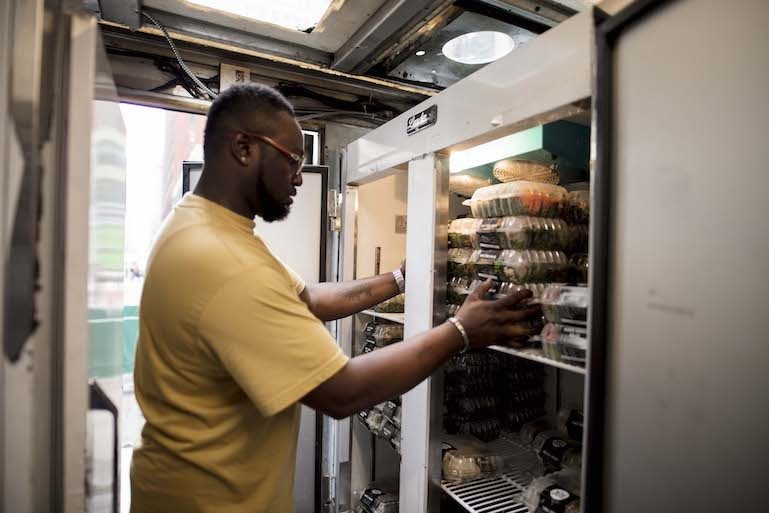
The Difference Between A Merchant Cash Advance And A Loan
We know it’s tricky to navigate through the murky financial waters of owning a small business. That’s why we like to tackle tough topics, like the difference between a merchant cash advance and a loan. So sit back and grab a cup of coffee — we’ll do all of the heavy lifting.
Traditional Term Loans
When your business is in need of capital, your next thought may lead you to a ‘bank loan’ – and rightfully so. Traditional banks have practiced the art of lending for centuries and have helped build our country. Whether you want to buy land, build a house, or start a business, if you need capital, you go to a bank.
You apply for a business loan, provide the necessary requirements, and if approved, the bank gives you a lump sum of cash in exchange for making monthly payments over a set period of time (or ‘term’) with a fixed or variable interest rate over the life of the loan. Depending on the term of the business loan, it would then be further sub-categorized as either a long-term or short-term loan.
Long Term Loans
Long-term loans are, you guessed it – loans with a repayment period significantly longer than what’s considered a short-term business loan. Repayment for a long-term business loan can be anywhere from 5 years to a decade or more.
Approvals for long-term loans are harder to come by because you have to contend with the strict qualifying standards of traditional banks. Most likely, you will also have to put up collateral and the bank may limit the amount of loans the business can take on in the future. Also, not only does your business have to be in good standing and have the financial statements to prove it, but your personal credit score will also have to be outstanding.
Long-term loans make more sense for established businesses with a stable business credit history that are looking to expand or acquire another company. In addition to the longer repayment term, these loans are generally higher dollar amounts (six-figures is common) and can have a lower interest rate than short terms loans. The Small Business Administration (SBA) is a great source for low-interest loans with varying terms for established businesses, and they are partially backed by the government. So, if you default on the loan, the federal government is responsible for paying back 85 percent of it.
However, borrower beware, the lower interest rate over a longer period of time can equal or surpass that of a short-term business loan over its lifespan, significantly increasing the repayment amount. Think about it.
SEE ALSO: How Much Does it Cost to Start a Retail Store?
Short Term Loans
As a small business owner, you’ll typically go with a short-term loan, even if you’re just starting out. A short-term loan is structured to provide more immediate funds. Short term loans are typically smaller amounts, have a slightly higher interest rate than long-term loans, and you guessed it – have a shorter payback period that can last a few months, to a few years.
Short term loans heavily rely on your personal credit and may require you to put up collateral if you’re going through a traditional financial institution such as a bank. However, on the bright side, there are more alternative financing sources for small business owners other than banks, but more on that later. That makes them easier to obtain even if you don’t have the best personal credit score or collateral to put against the loan.

The Difference Between Short and Long Term Loans
Short term loans are used for working capital needs (buying inventory, marketing, payroll). The use of funds is tied directly to generating revenue, and can, therefore, be paid back earlier. In other words, you use the loan for a business initiative that generates revenue quickly, which makes the higher interest rate less of an issue.
Long-term loans are used for expansion and growth. Initiatives like remodeling, buying equipment, buying out a partner, etc. are excellent reasons to take out a long-term loan. Since the initiatives aren’t directly tied to revenue generation (i.e. you aren’t using a long-term loan to fund a marketing campaign), they need a longer payback period to soften the blow of larger fixed monthly payments.
SEE ALSO: The Fundamentals: Where to Buy Coffee Shop Equipment
Secured and Unsecured Loans
The whole idea behind collateral is that it becomes a security net for the bank. If you want the bank to lend your business the money, they may require that you, the borrower, to pledge a piece of real estate or your assets such as inventory, in order to ensure repayment. If you default on the loan, the bank has the authority to seize the assets or real property in order to repay the debt. When you pledge collateral against a loan, it’s called a secured loan – meaning the bank is securing itself from losing out on as little money as possible.
On the other side of the spectrum, you have unsecured loans. Any idea how those are structured? You guessed it again, unsecured loans do not require the borrower to put up collateral. They are heavily based on your personal credit score and slightly based on the relationship history the borrower has with the lender.
Since you’re not providing the lender with any assets or property based security blanket, they are considered a bigger risk. And we all know that with a bigger risk means a bigger reward, right? So from a lender’s perspective, that bigger reward means a higher interest rate for you, which equals more (bigger) money (reward) for them.
Along the same lines, because you’re not putting up any collateral, you will be required to sign a Personal Guarantee (PG). A personal guarantee means that you are personally responsible for the repayment of that loan. Not the business, not another stakeholder, nor another partner. If you signed on the PG line, you are responsible for repayment.
Long-term loans are almost always secured, while short-term loans could go either way depending on your credit score, relationship with the bank, and if you’re willing to sign a personal guarantee. Lines of credit can also work in this manner where they are either secured or unsecured, and that brings us to our next point.
Lines of Credit
Lines of credit are worth a mention here because they are a version of, or a subcategory of a short-term business loan, but with a slight twist. They’re similar to a credit card in that once the lender approves you for a certain amount, it remains at your disposal. A line of capital is primarily used for working capital needs. They’re great for inventory purchases, operating costs, or they can also be used as general cash flow or capital if you’re in a pinch due to slow sales.
Unlike a loan where you have to reapply once you use up the funds, a line of credit is revolving. This means that if a bank decides to extend a line of credit to you for $30,000 and you take $10,000 to buy more inventory, or invest in marketing to grow sales, you still have $20,000 left to use, or not use. The bank will charge interest on that $10,000 until it’s paid off. When you pay down that $10,000, your credit line goes back to $30,000 without having to reapply like you would for a loan. So, even if you don’t need the cash right away, opening a line of credit sooner rather than later is a smart idea – it’s your security net.
SEE ALSO: 3 Types of Collateral to Use for Small Business Loans
Merchant Cash Advance
Up to this point, we’ve talked about different types of loans, short and long, secured and unsecured business loans, and even revolving lines of credit. Remember how we mentioned there was a bright side to short-term ‘loans?’ There are alternative financing sources for small businesses besides loans and lines of credit. Merchant Cash Advances (MCA) have been around since the 1990’s and businesses in the merchant cash advance industry were the pioneers in alternative financing. We use ‘loans’ in quotations because MCA’s are not at all the same as traditional business loans.
So if it’s not a loan, then what is a merchant cash advance?
The fine line between the two is that an MCA provides your business with a lump sum upfront, but rather than requiring monthly installments, a cash advance is remitted using a percentage of future credit card and debit card sales, or receivables withdrawn directly from your daily credit card revenue. This means that a merchant does not owe any funds until they generate sales. This flexibility provides great relief from the financial stress that may come with the other types small business funding that we described earlier.
Simply put, an MCA does not qualify as a loan because it’s a sale of future revenue. And because of that technicality, it’s not subjected to the scrutiny or regulations that are imposed on a standard small business loan. That means cash advances are a quick and easy way for merchants to acquire the cash flow they need, rather than waiting for a bank’s rigorous and slow approval process. Nor does it require a traditional payment schedule and your credit score plays no role in whether or not you qualify. In a nutshell, those are the differences between a merchant cash advance and a loan.
We know what you’re thinking, how can someone or some company buy a percentage of your future revenue from credit card sales or receivables and intercept that money automatically before you ever see it? Enter your payment processor, a.k.a your credit card processor. Credit card processors began partnering with merchant cash advance companies to make transferring funds much easier and faster for merchants. Since payment processors already had access to a merchant’s funding account for credit card sales, it made sense to use them to streamline the cash advance process. In some cases, payment processors would offer the service and funding in-house as a compliment to their core business offering. This became more mainstream in the early to mid-2000’s.

Benefits of an MCA
There are many benefits to an MCA over a loan for small business owners. Because they are not dependent on credit scores, it’s much easier for a merchant to be approved for a merchant cash advance than a loan. The application process for a loan is also often a lot more time-consuming and complex.
Since a merchant cash advance is fulfilled based on a percent of your future credit card sales, rather than a fixed amount, the actual amount the provider collects changes from month to month. This can be very beneficial for a merchant managing their cash flow. If you go through a slow season, the collections made on the cash advance decrease. If sales skyrocket, the collections increase. However, the percent that is collected never changes, keeping your business cash flow stable. With loans, you have a fixed repayment amount, which can put a serious dent in your bank account if you’re going through a sales slump.
We know merchant cash advances can give your business exactly what it needs without complications. That’s why we offer ShopKeep Capital: top-rated, lightning fast, merchant-first financing. Learn more about how you can fund your business with Capital.
Blurring The Line Between Cash Advances and Loans
Thanks to the success and popularity of merchant cash advances, traditional small business lenders were forced to step up their game and offer fast and flexible loans in order to stay competitive.
The quickness of cash advances alongside technology helped disrupt the traditional financing industry and opened the doors for a relatively new industry of online lending. Online lenders offer a variety of services, and financing options that resemble the ease and speed of a cash advance. The emergence of these alternative resources gives merchants like you a heck of a lot more resources for capital, cash flow needs, operating expenses or marketing campaigns.
SEE ALSO: The Ins and Outs of Small Business Financial Planning
Cash Advance or Loan? Which is Right for My Business?
So now that you know the difference between a merchant cash advance and a loan, how do you decide which one is right for your business? The answer is, it all depends on you and your unique business needs. Here are a few things to consider to point you in the right direction.
Credit
Your personal credit is a key component to help you establish business credit. Since loan repayments or lack thereof, are reported to credit bureaus, if you don’t have great personal credit, it may be harder to obtain a loan from traditional sources. If your credit is less than stellar, a merchant cash advance may be the better option.
Profits and Credit Card Revenues
Banks will look at your business’ overall profits and number of years in business as factors in determining whether or not you qualify for a loan. Companies that provide merchant cash advances are also interested in the amount of time you’ve been in business, but they’re more interested in your credit card revenues.
Fulfilling Your Agreement
To repay a traditional loan, you pay monthly installments of a fixed amount due at the same time each month. Cash advances are different. The remittance is taken out on either daily or weekly intervals, and the amount will fluctuate based on your credit card revenue. If you prefer to wait until you make money to fulfill your agreement, a cash advance would be the better option. If you’re seeking a firm repayment schedule, a loan is the better choice.
Use of Capital
Merchants like you will need capital for a variety of reasons. Maybe you need to buy new seasonal inventory and run a marketing campaign, which are ideal uses for cash advances because you anticipate making your money back relatively quickly. Maybe you need to buy some new equipment or just need a little extra cash flow during your slow months. If that’s the case, a loan or a line of credit from the bank would be the better option.
Looking For Funds?
ShopKeep is proud to drive serious growth for our merchants with ShopKeep Capital. Are you envisioning success? Visit ShopKeep Capital to learn more about how we can make your business goals happen.
Want to try ShopKeep for yourself?
Just answer a few easy questions.
Need help finding the right point of sale?
Just complete the form. We’ll call you right back to explain how ShopKeep can work for you.
Hit the ground running.Sprinting, in fact!
Read our free, comprehensive guide, Small Business 101, to learn all you need to know about starting a thriving business.

